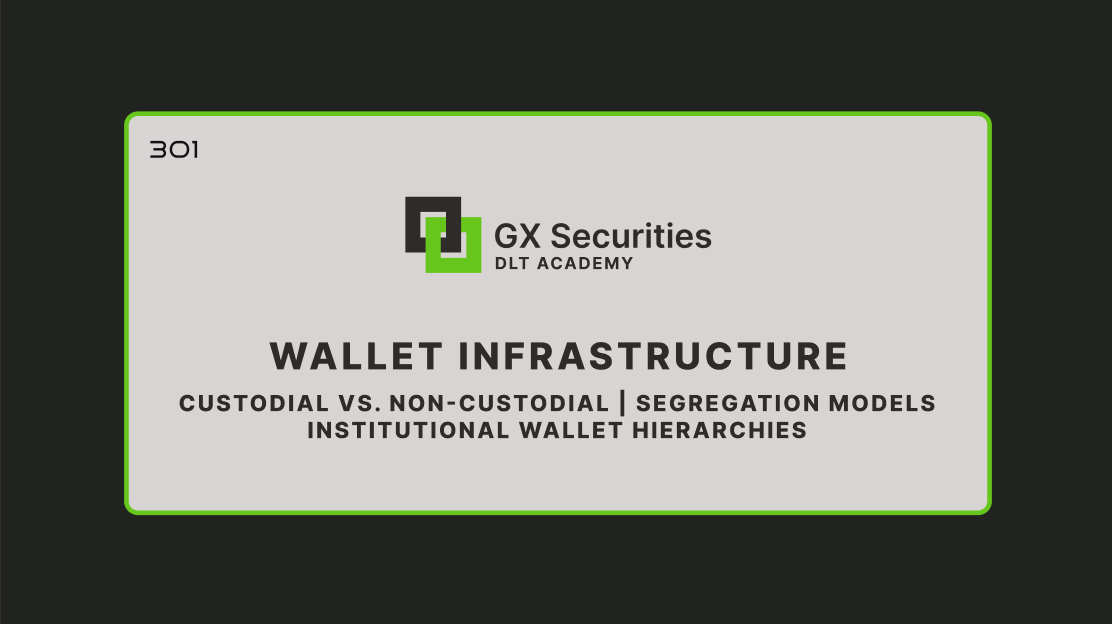
In tokenized finance, the digital wallet is far more than a technical endpoint. It serves as the foundation of ownership, compliance and governance in a blockchain-based financial system. For institutional investors and asset managers, wallet architecture is where technology meets fiduciary responsibility.
The way a wallet is structured directly impacts:
Unlike retail wallets, institutional systems must be designed for segregation of ownership, layered authorization, auditability and regulatory alignment, not just security. This module explores how wallet infrastructure underpins compliant tokenization and asset servicing at scale.
Custodial wallets are operated by regulated third parties on behalf of clients. The custodian controls the private keys, executes transactions per mandate and assumes fiduciary responsibility. This mirrors traditional trust structures and is often mandated by law in regulated markets.
Non-custodial wallets place full control and responsibility with the investor. The private key never leaves the client’s environment. While this offers direct ownership and reduces intermediary risk, it increases operational risk and complicates compliance enforcement.
Hybrid wallet models are emerging as a middle ground. These often use multi-signature schemes or Multi-Party Computation (MPC) to share control between clients and service providers, aligning with fund governance, audit and compliance needs.
Regulatory Note: Swiss FinIA and FinMIA, along with the EU's MiCA and DLT Pilot Regime, emphasize asset segregation and record traceability. Regardless of model, institutional wallets must provide verifiable ownership structures and access control.
In digital asset custody, legal segregation is paramount. Fund managers must avoid structures that:
Best practices include:
On the XRP Ledger (XRPL), trustlines, whitelists and freeze functionality offer powerful tools to enforce legal ownership boundaries and redemption rights.
Institutions require multi-tier wallet systems with built-in separation of duties. Common tiers include:
Operations Tier: Handles settlements, withdrawals and routine actions
Compliance Tier: Oversees whitelist changes, investor onboarding and transaction monitoring
Governance Tier: Executes strategic actions such as minting, redemptions, or capital allocation
These layers are often implemented through:
Multisig setups with quorum rules across departments or board members
On-chain smart contracts that enforce role-based permissions (e.g., XRPL Hooks)
Identity-linked signing rights, binding wallet access to verified individuals or legal entities
Increasingly, these architectures are not optional. Regulatory bodies under FATF, DLT Pilot Regime and FinSA/FinMIA now expect demonstrable internal controls around digital asset management.
Case Study: GXFlex (GXF)GX Securities issues regulatory-compliant tokens on XRPL using an institutional-grade wallet design:
This system enables full compliance with Swiss FinSA and Articles 73a-c of FinMIA, ensuring secure, auditable and investor-protective token custody.
Continue to: Module 3.2 – Cold Storage & Hardware Wallet Integration
Explore how institutions implement air-gapped wallets and disaster recovery plans.
Recommended: Module 3.5 – Custodian Partnerships & Regulatory Alignment
Learn how to design custody workflows with licensed Swiss and EU financial market partners.
Discover how GX Securities leverages the XRP Ledger for compliant DeFi infrastructure and tokenized asset operations on XRPL | Contact us at compliance@gxsecurities.com or send us an inquiry
Disclaimer
GX Securities operates solely as a DLT infrastructure provider and this article does not constitute financial advice or an offer of securities.
By entering, you confirm that you are an institutional or professional investor eligible under applicable regulations. Retail investors are not permitted. If you are not eligible, please exit.
GX Securities is a DLT infrastructure provider and does not offer investment services, advice or custody. DLT securities content is informational only and not an offer or solicitation.
I acknowledge and agree to the
Terms of Use
Privacy Policy